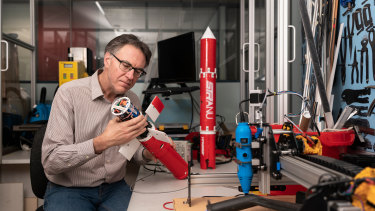Space age fire fighting technologies are being trialled in a $6 million project by the Australian National University and Optus to investigate the use of satellite warnings and aerial water bombing drones.
Satellites, long range infra-red monitoring, remote controlled drones and autonomous drones will be used in a four year program that is set to partner with emergency services.
Robotics expert Professor Rob Mahony, who is working on the bushfire warning and extinguishing system, with an autopilot glider that can be remotely guided to water bomb fires. Credit:Jamie Kidston / ANU.
The aim is to detect fires within moments of ignition and use machines to extinguish them before they grow too big to control.
Australian National University vice chancellor Professor Brian Schmidt said the new system was "would attack fires before they grow".
"ANU is designing and looking to build highly innovative water gliders with autopilots that will extinguish fires within minutes of them igniting," Professor Schmidt said.
ANU and Optus' first initiative will be a partnership with the ACT Rural Fire Service using long range infra-red cameras in Namadgi National Park for early fire detection.
It is set to launch a fleet of satellites by 2022, to beef up the early detection system.
Optus Enterprise Managing director Chris Mitchell said the telco would bring its existing network and satellite capabilities to an urgent issue.
"This is what it’s going to take to make a difference to building our nation’s resilience and capabilities for these catastrophic events," Mr Mitchell said.
The Black Summer fires highlighted the growing importance of aerial water-bombing, with the Australian Safety Transport Bureau recording four times more aerial firefighting activity than ever before.
Former Victorian Country Fire Authority chief Neil Bibby told The Sydney Morning Herald and The Age earlier this year that many of last summer's fires could have been controlled with greater aerial resources.
"It's a fundamental theory: put the fire out when it's small and then you don't have as big of a problem," he said.
Dozens of expert submissions and testimonies to the bushfire royal commission highlighted growing risks of dangerous bushfires due to climate change, and called for better deplyment systems and increased water-bombing capability to reduce the threat to fire-fighters on the ground.
Private owners of water-bombing fleets, which are contracted by state governments during fire seasons, told the commission of their frustration at watching small fires grow into dangerous blazes while they waited for an order from the state emergency services to fight the fire.
Philip Hurst, the chief executive of the Aerial Application Association of Australia, which represents pilots and operations staff, said firefighters were "labouring" under a lack of a "national overarching system" to deploy resources such as water-bombing aircraft.
"I can't imagine anything more frustrating than watching a fire get bigger and bigger while you're sitting on the ground waiting for dispatch," Mr Hurst said.
Most Viewed in Politics
Source: Read Full Article



